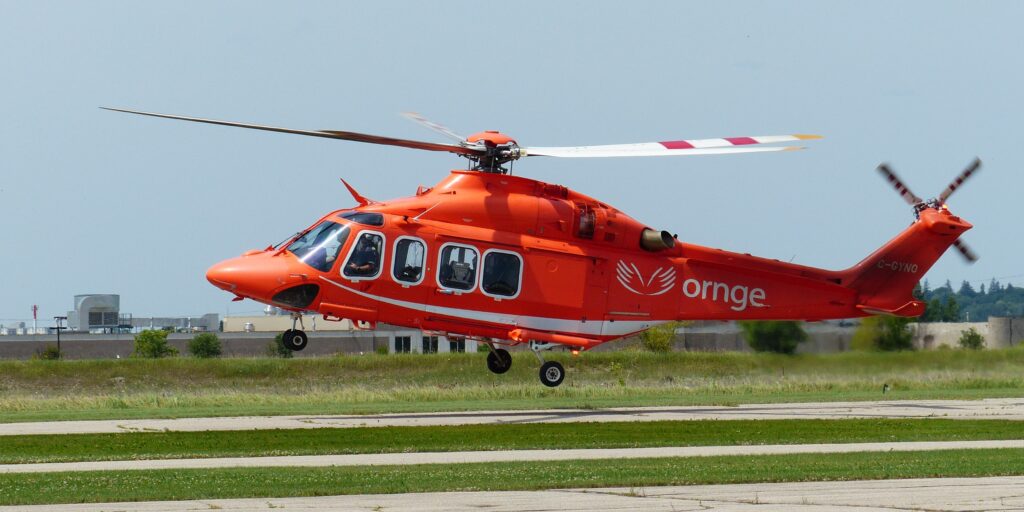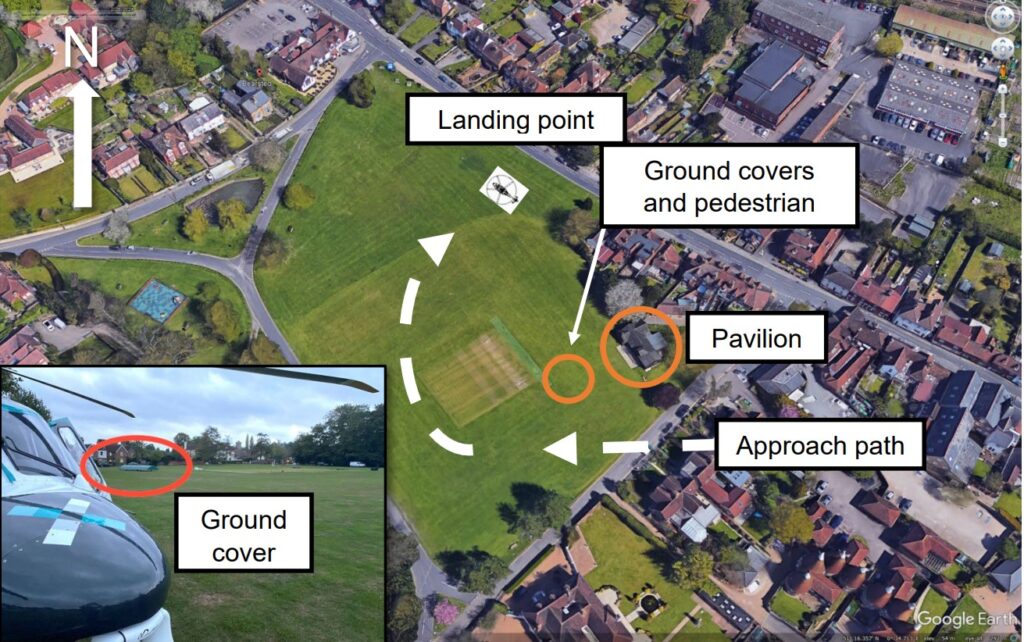HEMS Downwash Injuries: Two More Case Studies
We return again to a safety issue we have previously highlighted, namely helicopter downwash.
Case Study 1: AW169, G-KSSC, UK, 11 October 2023
On 11 October 2023 a bystander was injured when Leonardo AW169 air ambulance G-KSSC landed at Bearsted Common, Maidstone, Kent. The UK Air Accident Investigations Branch (AAIB) explain in their safety investigation report, issued 13 June 2024, that the Gama Aviation (formerly Specialist Aviation Service) / Air Ambulance Kent Surrey Sussex Helicopter Emergency Medical Service (HEMS) aircraft was on final approach to a cricket pitch, c 80 m from an emergency incident.
The crew assessed the field and established that its size, approximately 80 m by 120 m, was more than sufficient to use as a HEMS landing site.
In daytime a ‘2D’ sized clear area is required, which AAIB note is 30 m by 30 m for an AW169, though there are other considerations for safe operations, as this occurrence highlights.
The crew decided on an approach track that avoided the cricket pavilion and some residential properties to the north-east of the pitch.
Location of SAA G-KSSC HEMS Downwash Serious Incident at Cricket Club, Kent (Credit: UK AAIB)
This also allowed the approach to be conducted largely into wind, which was from the south-west.
The crew noted that there were pedestrians at the northern end of the field and some ground covers protecting the playing surface, but the main pitch area was clear. They elected to use a helipad profile approach with a committal height of 180 ft agl to provide sufficient clearance from surface obstructions.
On the final approach to land, when passing abeam the pavilion, the crew noticed that two previously unseen members of the public had appeared at the north-eastern edge of the cricket square, near the pavilion. The pilot flying stopped the descent at a height of approximately 160 ft agl to minimise the effect of the rotor downwash and extended his aiming point further into the area. As the crew established the helicopter in a hover at about 40 ft agl, one of the medical crew in the cabin noticed that the ground covers had rolled from their original position. The pilot flying decided to continue with the landing as any additional manoeuvring would risk blowing the covers further.
The helicopter was shut down and shortly after the crew were made aware a woman “had suffered a cut to her leg when one of the ground covers rolled towards her, striking her”. She was subsequently taken to hospital.

SAS (Now Gama Aviation) HEMS Leonardo AW169 of Air Ambulance Kent Surrey Sussex at Redhill, Surrey in 2019 (Credit: Jlewis94 CC BY-SA 4.0)
The Safety Investigation
It was found that…
…the covers were mounted on wheels which were equipped with brakes. The brakes had not been applied and the covers were moved easily.
AAIB comment that:
HEMS operations are inherently reactive and time sensitive. Due to the urgency involved, it is often impractical to provide formal site security measures to control access to third parties at landing sites.
The applicable regulatory guidance material, GM1 SPA.HEMS.100(a), sets out the “HEMS Philosophy” that includes the concept that “potential risk must only be to a level proportionate to the task”, with the following hierarchy of protection:
(1) third parties (including property) – highest protection;
(2) passengers (including patients); and
(3) crew members (including technical crew members) – lowest.
Oddly this puts third-party property above passengers and crew and equally with third party individuals. AAIB note that:
The speed of the downwash produced by a helicopter is a function of weight, air density and rotor diameter.
The rotor downwash reaches its maximum velocity between 1.5 and 2 times the rotor diameter below the helicopter, then reduces as it disperses outwards (sometimes referred to as ‘outwash’).
AAIB note that even 30 m from the helicopter, the downwash velocity only reduces by 17% and “can be influenced by terrain features, buildings or other substantial objects”. The entry for unprepared landing sites in the operator’s Risk Register stated that:
Aircraft Downwash may cause stones, loose crops, fences, branches to become detached and endanger the aircraft, third party public and surrounding buildings and vehicles.
Consequence: Aircraft damage or third party injury is possible due to debris created by downwash in smaller more confined unprepared landing sites.
AAIB not not explain what the assessment of probability and thus level of risk was. there is also no indication of when the risk register was last reviewed. The stated mitigations however included:
- The Operational Conversion Course and line training that concentrates on landing site selection and the hazards involved in operating to unprepared landing sites.
- HEMS Operating Site Procedures published in the Operations Manual, including the process for the conduct of a detailed airborne site survey.
- All pilots conducting an annual line check.
In other words: procedures, training and checking. One might imagine that the training and checking was orientated around the documented procedures. AAIB found that (our emphasis added):
The operator’s Operations Manual contained a general reference to rotor downwash, particularly the effect on other aircraft in close proximity. However, it did not contain detailed guidance on the effects of downwash at HEMS landing sites…
Despite lacking detailed guidance on downwash it did optimistically extoll pilots to be…
“acutely aware of the effects of their downwash when selecting HEMS landing sites”.
The operator did however publish a Flight Safety Circular to address downwash incidents in November 2021. The AAIB comment:
It provided a comprehensive summary of rotor downwash and reflected on how to plan operations at a landing site to anticipate and minimise the hazard.
The circular stated that: “This is especially important when operating within hostile congested areas and forms part of the HEMS pilot tool kit; running through a dynamic risk assessment based on the landing areas available and the aviation risk being proportional to the task”.
A few months after that circular was issued downwash from a coastguard S-92A resulting in fatal injury to a third party while landing at Derriford Hospital, Plymouth, Devon, 4 March 2022. The AAIB report was published just weeks after the Kent cricket pitch incident, however that accident was widely reported at the time.
The operator’s internal investigation acknowledged that:
Additional guidance on downwash risk diameter, effect of wind, downwash funnelling, FOD most at risk of disturbance, and features likely to dissipate downwash would assist a pilot in assessing the risk posed when considering a particular landing site.
This guidance was published 6 months after the occurrence on 10 April 2024, as a Flying Staff Instruction (FSI).
Case Study 2: AW139 C-GYNF, Canada, 1 June 2024
On 1 June 2024, Sunbury, Ontario based Leonardo AW139 C-GYNF operated by Ornge was conducting training for the medical crew which included hover exits and entries, which would take place near Wanapitei Lake, Ontario. It is reported that:
During a hover exit, a trainee was struck by a large piece of debris dislodged by the rotor downwash, and although they were wearing a helmet, they were knocked briefly unconscious.
The injured trainee was assisted back into the helicopter and transported to hospital in Sudbury.
We will update this case study when more details become available.

Ornge HEMS Leonardo AW139 in 2015 (Credit: JS Bond CC BY-SA 4.0)
UPDATE 9 January 2025: It emerges that a pedestrian passing the Helijet Nanaimo Harbour Heliport was blown over by S-76C C-GSHJ landing on 24 November 2024. The pedestrian received a serious injury. Helijet is reportedly “installing a new perimeter fence to mitigate the effects of rotor downwash”.
UPDATE 15 August 2025: Swiss HEMS arboreal helicopter downwash incidents:

Safety Resources
The European Safety Promotion Network Rotorcraft (ESPN-R) has a helicopter safety discussion group on LinkedIn. You may also find these Aerossurance articles of interest:
- Pedestrian Seriously Injured by Air Ambulance Landing at Melbourne Hospital
- Drift into Danger: AW109SP Night HLS Accident
- HEMS Black Hole Accident: “Organisational, Regulatory and Oversight Deficiencies”
- FOD and an AS350B3 Accident Landing on a Yacht in Bergen
- Air Methods AS350B3 Air Ambulance Tucson Tail Strike
- Air Ambulance B407 Hospital Helipad Deck Edge Tail Strike During Shallow Approach
- South Korean Fire-Fighting Helicopter Tail Rotor Strike on Fuel Bowser
- NTSB on LA A109S Rooftop Hospital Helipad Landing Accident
- Air Ambulance Helicopter Fell From Kathmandu Hospital Helipad (Video)
- US Air Ambulance Near Miss with Zip Wire and High ROD Impact at High Density Altitude
- Air Ambulance Helicopter Downed by Fencing FOD
- Hanging on the Telephone… HEMS Wirestrike
- Taxiing AW139 Blade Strike on Maintenance Stand
- Fire Extinguisher Cover Fenestron FOD
- After Landing this HEMS Helicopter Suddenly Started to Slide Towards it’s Hangar…
A Royal Navy Merlin suffered a downwash incident in 2016 (VIDEO).
BP has shared a useful video on the threat of downwash (albeit with focused on offshore helidecks):


Recent Comments